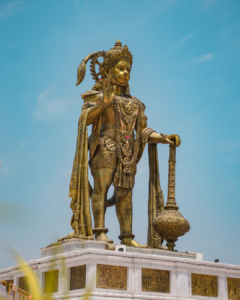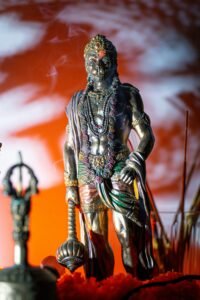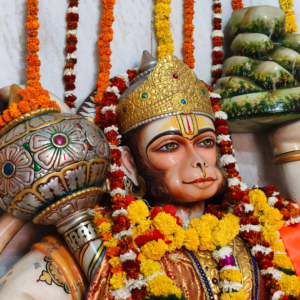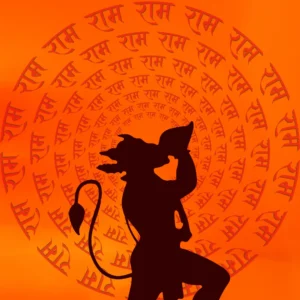Who wrote Shri Hanuman Chalisa? Tulsidas, Born in UP, India

Table of Contents
The Creator of Hanuman Chalisa: Goswami Tulsidas and His Sacred Heritage
Hanuman Chalisa is one of the most revered devotional mantra in Hinduism, and it is dedicated to Lord Hanuman, the very embodiment of devotion, courage, consistency and loyalty. The 40 chalisas written in the Awadhi language is read by millions of devotees across the globe to invoke protection, courage, and spiritual uplift. But who was this writer of the Hanuman Chalisa? Goswami Tulsidas, a 16th-century poet-saint, philosopher, and a devotee of Lord Rama, penned the Hanuman Chalisa.
Who Was Tulsidas?
Early Life and Spiritual Awakening
Tulsidas was born at Rajapur (now Uttar Pradesh, India) in 1532 CE (though some authorities date his birth as 1497 or 1554 CE). As per tradition, he was born after residing for twelve months in his mother’s womb, and rather than crying at birth, he made a “Rama” sound, which signified his divinely ordained mission.
He was born Rambola but was later known as Tulsidas (the “servant of the tulsi plant,” or one dedicated to Lord Vishnu). Abandoned at birth, he struggled but eventually was taken in by a saint named Narharidas, who instructed him in the Rama mantra and literature.
Among the qualities that comprised the life of Tulsidas was his intense love for his wife, Ratnavali. At nightfall, when she traveled to her father’s house, Tulsidas could not keep away from the isolation and swam a river to reach her. Disappointed by his attachment to the world, Ratnavali told him:
“If you had half as much love for Lord Rama, you would not have fear of birth and death.”
This struck very deep into Tulsidas, and he renounced worldly life and lived like an ascetic, devoted to Lord Rama alone.
Literary Works of Tulsidas
Tulsidas was a prolific author and composed different works in Awadhi and Braj Bhasha. His most famous works are:
Ramcharitmanas – Awadhi epic poem Ramayana, depicting Rama as the supreme god.
Hanuman Chalisa – 40-verse hymn extolling the virtues of Hanuman.
Vinaya Patrika – Collection of devotional prayers to Rama.
Dohavali – Doha compilation (couplets) on virtues and devotion.
Among all these, the Hanuman Chalisa is a prayer that is pan-border and universal.
The Story Behind the Hanuman Chalisa
It is said that Tulsidas composed the Hanuman Chalisa under extraordinary conditions. He was, as per tradition, imprisoned by Mughal emperor Akbar (or a local chief, to please others) for refusing to perform miracles. It was agonizing, and hence Tulsidas started reciting Hanuman’s stotrams.
Earlier, a troop of monkeys (Hanuman’s devotees) had taken over the palace, destroying it. The terror-stricken king let Tulsidas go and begged for clemency. Compassionately, Tulsidas composed the Hanuman Chalisa, which is said to provide safeguard, remove obstacles, and infuse with love.
Why the Hanuman Chalisa is So Powerful?
The Hanuman Chalisa is not just a prayer but God’s guard for the devotees. Its power lies in:
Devotional Submission – It expresses unwavering faith in the power and benevolence of Hanuman.
Poetic Power – The poetic couplets instill positive vibrations, dispelling fear and evil thoughts.
Miraculous Gains – By many it is believed that its recitation with dedication can heal diseases, ward off evil, and bestow righteous desires.
Tulsidas’ Legacy
Tulsidas left behind his mortal frame in 1623 CE at Assi Ghat, Varanasi. His teachings place emphasis on:
Bhakti (devotion) as the path to freedom.
Morality and righteousness in day-to-day life.
Selfless service to God in steadfast devotion, as seen in the case of Hanuman.
The Hanuman Chalisa continues to inspire so many people, demonstrating that the love of Tulsidas was not merely poetic but redemptive. His life teaches us that the highest spirituality is a result of love, surrender, and an indissoluble bond with the divine.
Goswami Tulsidas was more than a poet, a saint whose word carried godly power. Hanuman Chalisa is his timelessly bountiful contribution to humanity, a place where the human and divine meet. Reciting it, we are praying for Hanuman’s grace and recalling Tulsidas’ effort.
जय श्री राम! जय हनुमान

श्री आञ्जनेय चालीसा | Shri Anjaneya Chalisa
दोहाश्रीगुरु चरन सरोज रज, निज मन मुकुर सुधारि।बरनऊँ रघुबर बिमल जसु, जो दायक फल चारि॥ चौपाईजय हनुमान ज्ञान गुन सागर।जय

2025 Mahavir Jayanti: Date, History, Significance & Celebrations
Mahavir Jayanti 2025: Date, History, Significance & Celebrations Table of Contents Mahavir Jayanti 2025, the most sacred festival in Jainism,

Hanuman Jayanti 2025 Date & Time
Table of Contents Hanuman Jayanti 2025: Date, Puja Time, Significance, Rituals & Celebrations

Hanuman Bajrang Baan – बजरंग बाण
Hanuman Bajrang Baan – हनुमान बजरंग बाण ॥ दोहा ॥ निश्चय प्रेम प्रतीत ते, विनय करें सनमान ।तेहि के कारज

10 Famous Hanuman Temples in India That You Must Visit
10 Famous Hanuman Temples in India: A Spiritual Journey Lord Hanuman is one of the most famous deities worshipped in

8 Powerful Reasons to Chant Hanuman Chalisa Daily for Strength, Peace, and Protection
8 Powerful Reasons to Chant Hanuman Chalisa Daily for Strength, Peace, and Protection Why We Should Chant Hanuman Chalisa: Benefits
